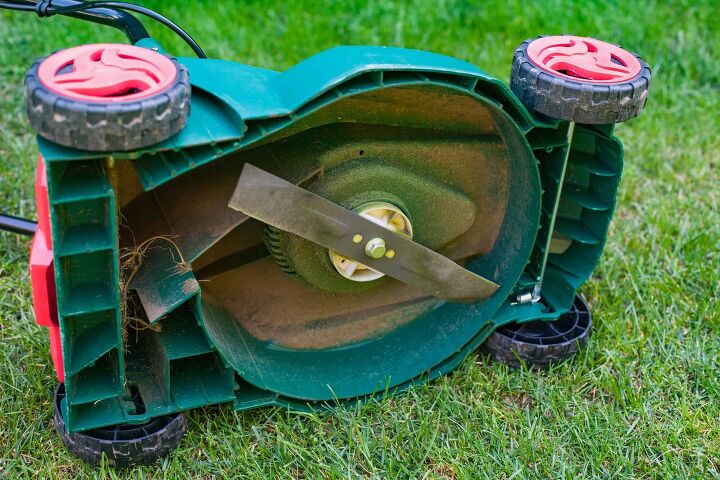Which Side of the Lawn Mower Blade is Up?

As the weather gets warmer, you’ll have to start mowing your lawn more frequently. Over time, wear and tear will cause the blades to wear down, which means that you have to replace them. However, one question that comes up during replacement is, “how do I know that the lawnmower blade is facing up?”
Your lawnmower is facing up if the sharp edge faces down at the ground, and the dull edge faces inside the mower. Look for the sticker or engraving that indicates that the mower is “up” to make sure. You must lay the lawnmower with the blades facing up when you change or sharpen them.
That being said, changing a lawnmower blade involves various steps, and you need to make sure that you do everything correctly. In this article, we’re going to outline this process in detail and provide additional information regarding your mower and its blades.
How to Tell if a Lawnmower Blade is Facing Up
When you receive your new lawnmower blade, you want to get it installed as quickly as possible. Unfortunately, because of the way lawnmowers work, both sides are not interchangeable. Figuring out which way is up can help you finish the job faster and ensure that your mower will work efficiently. Here are the top ways to determine the right orientation.
- Look for Stickers or Signs – In many cases, lawnmower manufacturers will place a sticker or marker on the blade’s correct side. Since these blades can seem confusing at first glance, these stickers can make the installation process much easier. If there isn’t a sticker, we recommend placing one on the blade so that it’s easier to identify next time.
- Check the Edges – To ensure that your mower cuts the grass more efficiently, the blade will have a tapered edge on one side. On the other side, the blade should be flat. Since the tapered side should be right side up, that will indicate the correct orientation.
- See if the Blades Wobble – Once you’ve finished installation, the lawnmower blade should be rigid. If there is any flexibility or wobbling, you have to correct the issue. In some cases, this problem may occur because the blade is upside down. In other instances, it could mean that you have to tighten the bolts.
Why the Orientation of the Blade is Crucial
At first, you may think that installing a lawnmower blade is not a big deal. As long as the sharp edge is facing out, what difference does its orientation make? Well, if the blade is upside down, it can cause some significant issues, including:
- Uneven Grass – The blade is flat on the bottom so that you get a crisp, even edge when mowing. If the blade is upside down, that means that the tapered side is facing the ground. As you mow, you’ll notice that the height of the grass will be misshapen. Depending on how close you cut it, this problem may be highly noticeable.
- Damaged Blades – Lawnmower manufacturers create the blades with a specific orientation in mind. If you install them incorrectly, it could cause unnecessary wear and tear. Over time, the edges may start to wobble more and more, causing chips and cracks. Also, they will dull faster, making it harder to cut the grass. Not only that, but you’ll have to replace the worn blades sooner.
- Damaged Mower – If the blades start to wobble, they can nick various parts of the lawnmower itself. Also, the turning mechanism may get damaged, particularly if you accidentally mow over a rock. The blade might knock the stone loose, sending it into the motor. In a worst-case scenario, you may have to get a new mower altogether.
Overall, it pays to check the orientation of the blade when installing it. Otherwise, you could wind up with costly repairs. At the very least, your lawn will look uneven, which can sometimes be worse than not mowing at all.
When to Change Your Lawnmower Blade
No matter how big your yard is or how often you mow it, your lawnmower blades will wear down over time. If you don’t change them for new ones, you will wind up with sloppy and uneven grass. Not only that, but the mower will have to work harder, which will use up more fuel. So, with that in mind, here are a few ways to tell that your blades are ready to be replaced.
- Uneven Patches – While most of your yard may look pristine, some spots might look patchy or messy.
- Ragged Tips – As the blades get duller, they start tearing the grass rather than cutting it. So, if the tips of your freshly mown grass look ragged, it’s likely time for a replacement.
- Manufacturer’s Recommendation – Typically speaking, most manufacturers recommend that you replace your blades after 25 hours or so. However, because many variables can affect the wear and tear, your blades may be able to last longer. However, if you’ve been using the same blades year after year without a change, it’s time to install new ones.
Different Types of Lawnmower Blades
Although cutting grass may seem like a straightforward process, there are different methods you can utilize. Because of this variety, there are three primary types of lawnmower blades: mulching, discharge, and bagging. When buying a replacement set, you must understand the differences between them.
Keep in mind that most mowers can accept multiple kinds of blades. Also, some blades may be able to do two different things, such as bagging and mulching. Be sure to check the manufacturer rating first so that you know they are compatible with your machine. Here is a quick breakdown of the three options.
- Mulching – If you don’t want to pick up clippings after you mow, we recommend a mulching blade. This set will chop the grass into fine pieces so that they can fertilize the lawn. However, to do this effectively, you need a mulching lawnmower.
- Discharge – This is the simplest type of blade, as it allows the grass clippings to blow out of the side of the mower. Usually, discharge blades have a lower angle to keep the suction levels down.
- Bagging – If you have a bag attached to the lawnmower, you need a blade that delivers a high suction rate. These blades are angled higher to ensure that most of the clippings wind up in the bag.
Related Questions
What if I have a reel lawnmower?
Since these mowers are hand-pushed and come with cylindrical blades, the orientation doesn’t matter as much. In this case, we recommend following the manufacturer’s installation recommendations.
Can I sharpen my blades instead of changing them?
If you want to save money, it might make sense to sharpen your blades instead of replacing them. To do this, however, you will need a power grinder. If you don’t have one, you’ll have to send your blades to get professionally sharpened. In some cases, this process may be as expensive as buying new ones, and it will undoubtedly take longer.
Related Guides

We are a team of passionate homeowners, home improvement pros, and DIY enthusiasts who enjoy sharing home improvement, housekeeping, decorating, and more with other homeowners! Whether you're looking for a step-by-step guide on fixing an appliance or the cost of installing a fence, we've here to help.
More by Upgraded Home Team















![Cost To Drill A Well [Pricing Per Foot & Cost By State]](https://cdn-fastly.upgradedhome.com/media/2023/07/31/9074980/cost-to-drill-a-well-pricing-per-foot-cost-by-state.jpg?size=350x220)











